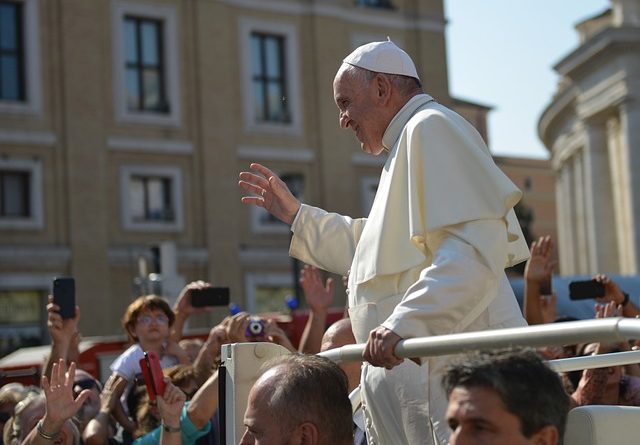The Anti-Catholic Chronicles: Chapter I Section A Introduction
It is fitting that a Baltimore newspaper should publish a monograph about anti-Catholicism in America. Maryland was a colony founded for Catholics, and Lord Baltimore, after whom the city was named, was Catholic. Maryland is also the home of the oldest Catholic Church in the original 13 colonies—St. Francis Xavier was founded in 1731 in Compton.
Perhaps my interest in writing this chronicle stems from being a member of the congregation of the oldest Roman Catholic congregation in Pennsylvania, Old St Joseph’s Parish, Philadelphia, and an alumnus of St. Joseph’s University, Philadelphia’s Jesuit University.
Perhaps it is due to attending St. Mary’s Catholic Church in Philadelphia, about 100 yards south of Old St. Joseph’s Church on S. 4th Street. Both are less than two blocks from Independence Hall. Indeed, George Washington attended Catholic Mass at St. Mary’s while a member of the Continental Congress. Or maybe the inspiration is derived from attending Easter Sunday Mass at St. Peter’s Square, Vatican City, in 2009.
Whatever the relevance, inspiration, or motivation to address anti-Catholicism, it is vital that it be chronicled. I note that in this Age of Grievance and Victimhood in America (and Europe), anti-Catholicism has been ignored and intentionally so. The Grievance and Victimhood zealots have movements lamenting the treatment of everyone and everything in America and Europe. They have slogans lamenting the treatment of whales, pets, rainforests, Blacks, Hispanics, Asians, Indigenous People, Palestinians, Israelis, Muslims, Jews, Gays, Lesbians, and even people who are unsure if they are a man or a woman.
They have slogans lamenting the treatment of everybody and everything except Catholics.
On page 19 of his 1956 book American Catholicism, John Tracy Ellis famously wrote that there are four stages of Catholicism in America. The first stage was “a universal anti-Catholic bias was brought to Jamestown in 1607 and vigorously cultivated in all the thirteen colonies from Massachusetts to Georgia.”
He attributed this to a hangover from the European religious wars, which mainly manifested in England with the Protestant Reformation during the reigns of Henry and Edward, the Marian Catholic Restoration, and finally, the Elizabethan Settlement. These factors inculcated the miso-Catholicism that would characterize American life to varying degrees for four hundred years. The criticism has changed from the 17th-century English Protestants’ claims of Popery to the 21st century Leftwing Jews’ antipathy to Catholic’s opposition to abortion, opposition to homosexual marriages, and opposition to transgenderism. But it is still rooted in MisoCatholicism.
Georgia Tech football fans threw mackerels at Notre Dame football players during their 1978 game in Atlanta. Why throw mackerels? Mackerel snapper is a pejorative term for Catholics that originated in America in the 1850s. It refers to the Catholic practice of eating fish on Fridays. Notre Dame University was then and is still the preeminent Catholic college football team, so the White Anglo-Saxon Protestant Georgia Tech football fans were mocking Notre Dame’s Catholicism.
This manifestation of contempt for Catholics did not begin in 1978. The Georgia Tech-Notre Dame college football rivalry in the 1920s was a focal point of anti-Catholic hatred by the Ku Klux Klan when the game was played in Atlanta.
The term was also used in the 1957 film Heaven Knows Mr. Allison ( a personal favorite). Set during World War II, a Marine ( Robert Mitchum) and a Catholic nun ( Deborah Kerr) are stranded on a Japanese-held island. The presumably Protestant Marine explains to the nun that in the Marines, the guys who go see the chaplain the night before an attack and eat fish on Friday (i.e. Catholics) are called mackerel snappers.
Another aspect of anti-Catholicism in America has been the alleged infiltration of the Catholic clergy by communists. This was attested to by the American communist leader Bella Dodd and repeated by Bishop Fulton J Sheen on April 27, 1952, as reported in the New York Times. Sheen made his remarks at a church in Rome. The allegation is that in 1936, approximately 1000 communists had been admitted to the Catholic clergy and were spreading communist beliefs throughout the Catholic Church.
If true, this would explain many of the changes that occurred in the Catholic Church, including, but not limited to, the spreading of liberation theology that the Vatican felt was oriented towards Marxism and incompatible with Catholicism. Nonetheless, the participation of Catholic clergy in communist-instigated revolutions in Latin America provided ammunition for anti-Catholics.
Part B of this series will provide more detail of the early history of American anti-Catholicism.
@Michael P Tremoglie 2024

Michael P. Tremoglie is a retired newspaper columnist. He was an investigative reporter for the Philadelphia Bulletin and a regular contributor to the Philadelphia Inquirer, Philadelphia Daily News, Pittsburgh Tribune-Review, and the Washington Times. He also served as a Philadelphia police officer.


Very interesting and well written article! Don’t check my FB IMs that frequently, but did today, and would love to read part B. Please send!
Thanks, Michael. Finally someone is speaking up about the last acceptable prejudice.